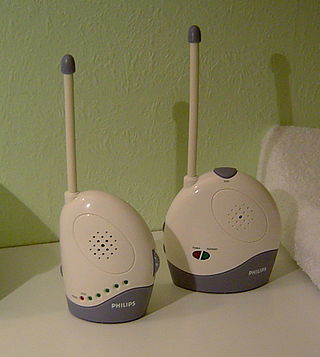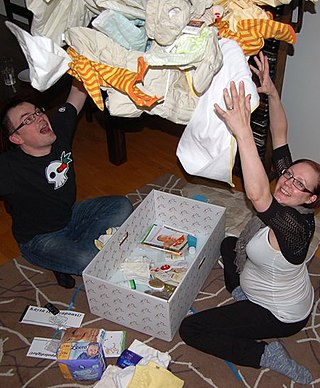Related Research Articles

Sudden infant death syndrome (SIDS) is the sudden unexplained death of a child of less than one year of age. Diagnosis requires that the death remain unexplained even after a thorough autopsy and detailed death scene investigation. SIDS usually occurs during sleep. Typically death occurs between the hours of midnight and 9:00 a.m. There is usually no noise or evidence of struggle. SIDS remains the leading cause of infant mortality in Western countries, constituting half of all post-neonatal deaths.

Attachment parenting (AP) is a parenting philosophy that proposes methods aiming to promote the attachment of parent and infant not only by maximal parental empathy and responsiveness but also by continuous bodily closeness and touch. The term attachment parenting was coined by the American pediatrician William Sears. There is no conclusive body of research that shows Sears' approach to be superior to "mainstream parenting".
Co-sleeping or bed sharing is a practice in which babies and young children sleep close to one or both parents, as opposed to in a separate room. Co-sleeping individuals sleep in sensory proximity to one another, where the individual senses the presence of others. This sensory proximity can either be triggered by touch, smell, taste, or noise. Therefore, the individuals can be a few centimeters away or on the other side of the room and still have an effect on the other. It is standard practice in many parts of the world, and is practiced by a significant minority in countries where cribs are also used.

A baby monitor, also known as a baby alarm, is a radio system used to remotely listen to sounds made by an infant. An audio monitor consists of a transmitter unit, equipped with a microphone, placed near to the child. It transmits the sounds by radio waves to a receiver unit with a speaker carried by, or near to, the person caring for the infant. Some baby monitors provide two-way communication which allows the parent to speak back to the baby. Some allow music to be played to the child. A monitor with a video camera and receiver is often called a baby cam.
The Ferber method, or Ferberization, is a technique invented by Richard Ferber to solve infant sleep problems. It involves "sleep-training" children to self-soothe by allowing the child to cry for a predetermined amount of time at intervals before receiving external comfort.

An infant bed is a small bed especially for infants and very young children. Infant beds are a historically recent development intended to contain a child capable of standing. The cage-like design of infant beds restricts the child to the bed. Between one and two years of age, children are able to climb out and are moved to a toddler bed to prevent an injurious fall while escaping the bed.

A bassinet, bassinette, or cradle is a bed specifically for babies from birth to about four months. Bassinets are generally designed to work with fixed legs or caster wheels, while cradles are generally designed to provide a rocking or gliding motion. Bassinets and cradles are distinguished from Moses baskets and carry cots, which are designed to be carried and sit directly on the floor or furniture. After four months, babies are often transferred to a crib or cot. In the United States, however, the bedside sleeper is the prevalent option, since they are generally bigger, recommended up to 6 months, and often used up to a year.

A nursery is usually, in American connotations, a bedroom within a house or other dwelling set aside for an infant or toddler. A typical nursery would contain a cradle or a crib, a table or platform for the purpose of changing diapers, a rocking chair, as well as various items required for the care of the child. A nursery is generally designated for the smallest bedroom in the house, as a baby requires very little space until at least walking age; the premise being that the room is used almost exclusively for sleep. However, the room in many cases could remain the bedroom of the child well into their teenage years, or until a younger sibling is born, and the parents decide to move the older child into another larger bedroom, if one should be available.

The Safe to Sleep campaign, formerly known as the Back to Sleep campaign, is an initiative backed by the US National Institute of Child Health and Human Development (NICHD) at the US National Institutes of Health to encourage parents to have their infants sleep on their backs to reduce the risk of Sudden Infant Death Syndrome, or SIDS. The target age group of the campaign is 0–1 years of age, because this is when babies are at the greatest risk of experiencing SIDS. Since "Safe to Sleep" was launched in 1994, the incidence of SIDS has declined by more than 50%. However, there has been a rise in infant sleep-related suffocation events. Consequently, the campaign has broadened its goal to focus on safe sleep conditions and further preventative measures.
Amy Spangler is a breastfeeding expert and president of baby gooroo who has lectured extensively and published several books on breastfeeding. In addition to earning a bachelor's and master's degree in nursing, Spangler is a registered nurse and an internationally board certified lactation consultant, and she has held leadership positions with national and international organizations including President of the International Lactation Consultant Association. She has also served as an expert contributor to Breastfeeding.com and as a member of their professional advisory board.

Harvey Neil Karp, FAAP is an American pediatrician, author, and child development specialist. He is best known for his book "The Happiest Baby on the Block" and its accompanying DVD, that use his "5 S's" approach to infant care. He is also the creator of the Snoo, a smart bassinet.

A travel cot is a bed for use by a baby or young child that collapses or folds into a bag for easy carriage. Travel cots are typically much lighter than a standard cot, with soft sides to provide comfort to the baby when sleeping.
Sleep training is a set of parental intervention techniques with the end goal of increasing nightly sleep in infants and young children, addressing “sleep concerns”, and decreasing nightime signalling. Although the diagnostic criteria for sleep issues in infants is rare and limited, sleep training is usually approached by parent(s) or caregivers self indentifying supposed sleep issues.
Infant feeding is the practice of feeding infants. Breast milk provides the best nutrition when compared to infant formula. Infants are usually introduced to solid foods at around four to six months of age.

Baby furniture refers to furniture created for babies. It is often used to help the parents of the baby keep it safe and comfortable in the home. Before baby furniture, parents would sleep with their children in their own beds, which could be dangerous for the child. Eventually, infant beds started to be built with the child's safety in mind; the intention was to keep the baby from rolling off the bed, so mangers and bassinets were created. Over time, more furniture was created with the infant's safety in mind, and there are several types and functionalities of these. Typical pieces include an infant bed, changing table, high chair, playpen, baby walker, and toy chest. Products, features, and costs vary between countries and have changed over time. Safety is of paramount importance.

The maternity package, known internationally as the Finnish "baby box," is a kit granted by the Finnish social security institution Kela, to all expectant or adoptive parents who live in Finland or are covered by the Finnish social security system. The package contains children's clothes and other necessary items, such as nappies, bedding, cloth, gauze towels and child-care products. It was first issued in 1938 to parents with a low income, and contained a blanket, crib sheets, diapers, and fabric which parents could use to make clothing for the baby.
Infant and toddler safety are those actions and modifications put into place to keep babies and toddlers safe from accidental injury and death. Many accidents, injuries and deaths are preventable.
Newborn care and safety are activities and precautions recommended for new parents or caregivers. It is an educational goal of many hospitals and birthing centers to promote newborn care and safety as parents take their infant home.
James Joseph McKenna is an American biological anthropologist. McKenna founded and directed the Mother-Baby Behavioral Sleep Laboratory at the University of Notre Dame, studying the physiology and behavior of co-sleeping mothers and infants. He has published over 140 scientific articles in medical and anthropological journals on the topics of co-sleeping, breastfeeding, evolutionary medicine, and SIDS, and is the author of several trade and academic books. He also regularly lectures on specialized topics relating to co-sleeping and breastfeeding, particularly to pediatric medical professionals and parents.

Infant sleep is an act of sleeping by an infant or a newborn. It differs significantly from sleep during adulthood. Unlike in adults, sleep early in infancy initially does not follow a circadian rhythm. Infant sleep also appears to have two main modes - active, associated with movement, and quiet, associated with stillness - exhibiting distinct neurological firing patterns. Sleep duration is also shorter. As the infant ages, sleep begins to follow a Circadian rhythm and sleep duration increases. Infants nap frequently. Infants are also particularly vulnerable during sleep; they are prone to suffocation and SIDS. As a result, "safe" sleep techniques have been the subject of several public health campaigns. Infant sleep practices vary widely between cultures and over history; historically infants would sleep on the ground with their parents. In many modern cultures, infants sleep in a variety of types of infant beds or share a bed with parents. Infant sleep disturbance is common, and even normal infant sleep patterns can cause considerable disruption to parents' sleep. As a result, there are a wide variety of interventions and products intended to improve infant sleep; however, their efficacy is variable. Infant sleep training is one common intervention for poor infant sleep. Poor infant sleep is linked to maternal depression.
References
- 1 2 "Bedside Sleepers Business Guidance & Small Entity Compliance Guide". United States Consumer Product Safety Commission. Retrieved 11 December 2017.
- ↑ Consumer Product Safety Commission, supra note 83.
- 1 2 "ISIS : Side-Car Cribs, Bedside Cots, and Co-Sleepers - ISIS Online". isisonline.org.uk. Archived from the original on 22 April 2017. Retrieved 2 February 2017.
- ↑ "Cosleeping Around The World - The Natural Child Project". naturalchild.org. Retrieved 2 February 2017.
- 1 2 Clemens, Eileen; Dhawan, Neha; Ensign, Larisa; Powers, John, Safe Bedside Sleeper Stand-Alone Unit (PDF), Jwo Pan, University of Michigan (coursework)
- ↑ McKenna, J. J.; Mosko, S. S.; Richard, C. A. (1 August 1997). "Bedsharing promotes breastfeeding". Pediatrics . 100 (2): 214–219. doi:10.1542/peds.100.2.214. PMID 9240802.
- ↑ McKenna, J.; et al. (1994). "Experimental studies of infant-parent co-sleeping: Mutual physiological and behavioral influences and their relevance to SIDS (sudden infant death syndrome)". Early Human Development. 38 (3): 187–201. doi:10.1016/0378-3782(94)90211-9. PMID 7821263.
- ↑ Blair, P. S.; Fleming, P. J.; Bensley, D.; et al. (1999). "Where Should Babies Sleep – Along or With Parents? Factors Influencing the Risk Of SIDS in the CESDI Study". British Medical Journal. 319 (7223): 1457–1462. doi:10.1136/bmj.319.7223.1457. PMC 28288 . PMID 10582925.
- ↑ "Co-sleeping Safely: A Guide to the Current Regulations of Infant Bedside Sleepers - Stinson Leonard Street". stinson.com. Archived from the original on 2 February 2017. Retrieved 2 February 2017.